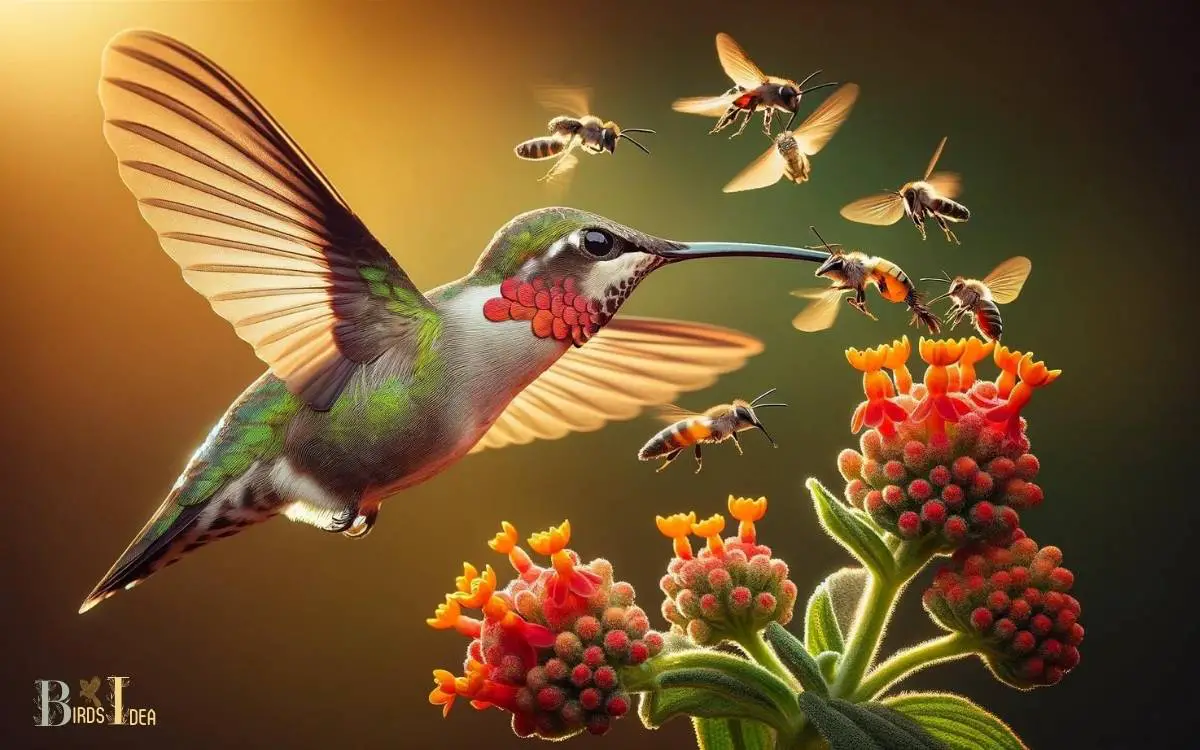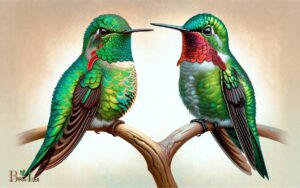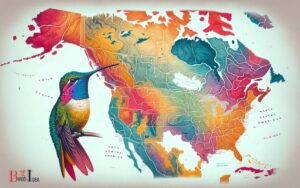Do Ruby Throated Hummingbirds Eat Insects? Yes!
Yes, Ruby-throated Hummingbirds do eat insects. They primarily consume nectar from flowers but supplement their diet with small insects and spiders for protein.
Ruby-throated Hummingbirds, known for their dazzling iridescent plumage and rapid wing flapping, have a diet that extends beyond the sweet nectar of flowers.
These tiny birds are also insectivorous, which means they regularly consume insects and spiders.
This aspect of their diet is crucial for providing them with essential proteins and nutrients that are not found in nectar.
Their foraging for insects can involve catching them in mid-air (hawking), gleaning them from leaves or spider webs, or even plucking them from the surfaces of water.
Some common insects they eat include:
These insects serve as a vital source of protein for hummingbirds, especially during the breeding season when females require additional nutrients for egg production, and during migration when energy demands are high.
The Ruby-throated Hummingbird’s insectivorous habits are essential for its dietary balance, ensuring it gets the necessary protein alongside nectar’s energy.

Key Takeaway
Ruby-throated Hummingbird Diet
The Ruby-throated Hummingbird diet consists primarily of nectar, supplemented with a variety of insects.
As nectarivores, these hummingbirds rely heavily on the energy-rich nectar produced by various flowering plants.
Their long, specialized bills and tongues are perfectly adapted for reaching deep into flowers to extract the nectar. This high-sugar diet provides the necessary fuel for their incredibly high metabolism.
In addition to nectar, they also consume a range of insects including spiders, fruit flies, gnats, and small bees.
These insects provide essential proteins and fats, supplementing their diet with necessary nutrients for their survival and breeding.
The consumption of insects also becomes particularly important during the breeding season when the high protein content supports the increased energy demands of nesting and raising young.
This dietary diversity emphasizes the hummingbird’s role as both a nectarivore and an insectivore, highlighting the intricate balance of their feeding habits.
This balanced diet ensures that the Ruby-throated Hummingbird meets its nutritional requirements, supporting its remarkable abilities and behaviors.
Insect Consumption Patterns
The insect consumption patterns of Ruby-throated Hummingbirds play a crucial role in their feeding habits and overall dietary requirements.
Understanding the extent to which insects contribute to their diet provides valuable insights into their foraging behavior and energy needs.
Exploring the impact of insect consumption on these hummingbirds can shed light on their ecological niche and the interconnectedness of their diet with the broader ecosystem.
Hummingbird Insect Diet
Ruby-throated hummingbirds primarily consume insects during the breeding season to meet their high protein requirements for egg production and chick rearing. Their insect diet is crucial for their reproductive success.
The table below illustrates the diverse range of insects that hummingbirds consume, showcasing their remarkable hunting abilities and adaptability to various insect species.
| Insect Type | Examples | Importance |
|---|---|---|
| Mosquitoes | Aedes, Culex | Important food source due to their abundance and high protein content |
| Aphids | Greenfly, Blackfly | Provides essential nutrients and energy for hummingbirds |
| Spiders | Orb weavers, Jumping | Rich source of protein and vital for meeting the hummingbird’s dietary needs |
Hummingbirds exhibit specialized foraging techniques to capture these insects, displaying an extraordinary level of precision and agility in their feeding behavior.
Impact on Feeding Habits
During the breeding season, Ruby-throated hummingbirds exhibit distinct insect consumption patterns, significantly impacting their feeding habits.
This species primarily consumes insects to meet their protein requirements, especially during the breeding season when they need additional energy for nesting and rearing young.
Their feeding habits are influenced by the availability of insects, which varies with environmental factors such as temperature and humidity.
The impact of insect consumption patterns on their feeding behavior is evident in their foraging strategies, as they actively seek out areas with high insect activity.
Additionally, the nutritional value of different insect species plays a crucial role in shaping their feeding habits, with certain insects providing essential nutrients required for breeding success.
Importance of Insects in Diet
The importance of insects in the diet of Ruby-throated Hummingbirds lies in the high protein content they provide, which is essential for the birds’ energy requirements during migration and breeding.
Additionally, insects offer a rich source of essential nutrients and vitamins that are vital for the hummingbirds’ overall health and well-being.
Understanding the nutritional benefits of insects in the diet of Ruby-throated Hummingbirds is crucial for their conservation and management.
Insect Protein Essential
An essential part of the ruby-throated hummingbird’s diet is insect protein. Insects provide vital nutrients and energy that these tiny birds need to sustain their rapid metabolism and long migrations.
The importance of insects in the diet of ruby-throated hummingbirds cannot be overstated due to the following reasons:
- High Protein Content: Insects are rich in protein, which is crucial for the growth, development, and maintenance of the hummingbird’s muscles and tissues.
- Essential Amino Acids: Many insects contain essential amino acids that hummingbirds cannot produce on their own, making them essential for the bird’s overall health and well-being.
- Energy Source: Insect protein serves as a high-energy food source, providing the necessary fuel for the hummingbird’s high metabolic rate and demanding flight patterns.
- Nutrient Diversity: Insects also offer a variety of essential vitamins, minerals, and other nutrients that contribute to the hummingbird’s overall nutritional needs.
Nutritional Benefits of Insects
In light of the high protein content and essential amino acids found in insects, it is evident that these organisms play a crucial role in meeting the nutritional needs of the ruby-throated hummingbird.
Insects are an essential component of the hummingbird’s diet, providing vital nutrients such as protein, fats, vitamins, and minerals.
The high protein content in insects is particularly important for the growth, development, and maintenance of the hummingbird’s muscles and overall health.
Additionally, insects also serve as a source of essential amino acids that are necessary for various physiological processes within the hummingbird’s body.
The nutritional benefits of insects cannot be understated, as they contribute significantly to the hummingbird’s ability to meet its energy requirements and sustain its high metabolic rate, essential for its active lifestyle.
Dietary Adaptations
Although primarily known for their nectar-feeding behavior, Ruby Throated Hummingbirds also incorporate a significant amount of insects into their diet to meet their high metabolic demands.
This dietary adaptation allows them to obtain essential nutrients and energy. Their insect consumption includes:
- Tiny spiders and their eggs
- Mosquitoes and other small flying insects
- Aphids and gnats
- Insect eggs and larvae
The consumption of these insects provides the hummingbirds with high-quality proteins, fats, and vitamins necessary for their survival.
By including insects in their diet, Ruby Throated Hummingbirds demonstrate their ability to adapt to diverse food sources, allowing them to thrive in various environments.
This dietary adaptation highlights the importance of understanding their insect-eating behavior and its impact on their overall health and survival.
Insect-Eating Behavior
Ruby Throated Hummingbirds exhibit a diverse insect-eating behavior to supplement their nectar-heavy diet. These tiny birds are adept at catching insects in flight, and they also glean insects from leaves, bark, and flowers.
The table below outlines the various types of insects that Ruby Throated Hummingbirds consume as part of their diet.
| Insect Type | Consumption Method | Seasonality |
|---|---|---|
| Mosquitoes | In-flight capture | Summer |
| Gnats | Gleaning | Spring/Fall |
| Aphids | Hover-and-snap | Spring/Summer |
This insect-eating behavior provides essential proteins and fats, supplementing the hummingbird’s predominantly sugary diet.
The consumption of insects also aids in providing essential nutrients during breeding and molting periods.
Nutritional Benefits of Insects
The insect consumption of Ruby Throated Hummingbirds significantly contributes to their overall nutrition and well-being, particularly through the intake of essential proteins and fats.
This diet provides the following nutritional benefits:
- High-quality proteins: Insects are rich in high-quality, easily digestible proteins, which are vital for muscle development and repair.
- Essential fats: Insects contain essential fats such as omega-3 and omega-6 fatty acids, which are crucial for maintaining healthy plumage and energy production.
- Vitamins and minerals: Insects are a rich source of vitamins and minerals, including vitamin E, iron, and calcium, which are essential for overall health and reproductive success.
- Antioxidants: Certain insects contain antioxidants that help hummingbirds combat oxidative stress and support their immune system.
This nutritional intake from insects underscores the importance of this dietary component for the well-being of Ruby Throated Hummingbirds.
Feeding Strategies
Utilizing their agility and precision, the Ruby Throated Hummingbird’s feeding strategies are essential for capturing insects to meet their nutritional needs.
These birds primarily employ two main feeding strategies to catch insects: aerial hawking and gleaning.
Aerial hawking involves the hummingbird hovering in mid-air and darting after flying insects with remarkable speed and accuracy.
This strategy allows them to catch insects on the wing, such as gnats, mosquitoes, and fruit flies.
In contrast, gleaning involves the hummingbird perching and carefully plucking insects from leaves, bark, or flowers.
This method enables them to target stationary or slow-moving prey like spiders, aphids, and other small arthropods.
The combination of these feeding strategies enables Ruby Throated Hummingbirds to efficiently supplement their nectar-based diet with essential proteins and nutrients.
Impact on Reproductive Success
Hummingbirds depend on insects for both nourishment and the successful rearing of their offspring through the consumption of protein-rich prey during the breeding season.
The impact of insects on the reproductive success of Ruby-throated hummingbirds is profound.
Here’s how:
- Egg Development: The high protein content in insects aids in the development of hummingbird eggs, ensuring optimal growth and health of the embryos.
- Chick Growth: Insects provide essential nutrients for the rapid growth of hummingbird chicks, enabling them to fledge successfully.
- Parental Care: Insects are crucial for sustaining the high energy demands of parent hummingbirds during the nesting period.
- Survival Rates: Availability of insects directly influences the survival rates of both adult hummingbirds and their young.
This intricate relationship between hummingbirds and insects underscores the vital role of insect consumption in ensuring reproductive success.
This has significant conservation implications as the availability of insect prey directly impacts the reproductive success of hummingbirds.
Conservation Implications
In considering the conservation implications, it is imperative to assess the dependency of Ruby-throated hummingbirds on insects for reproductive success.
As primary consumers of insects, these hummingbirds play a crucial role in controlling insect populations, particularly in their breeding habitats.
The availability of insects significantly impacts the reproductive success of Ruby-throated hummingbirds, as they rely on high-protein insect diets to meet the nutritional demands of egg production and chick rearing.
Therefore, any decline in insect populations due to habitat loss, pesticide use, or climate change could have detrimental effects on the breeding success of these hummingbirds.
Conservation efforts should focus on preserving diverse and abundant insect populations within the hummingbirds’ habitats to ensure their reproductive success and long-term population sustainability.
Understanding and addressing the insect-dependent nature of Ruby-throated hummingbirds is essential for effective conservation strategies.
Conclusion
The diet of the ruby-throated hummingbird primarily consists of insects, which provide essential nutrients for their survival and reproductive success.
While some may argue that insects are not the only source of nutrients for these hummingbirds, the evidence overwhelmingly supports the significance of insects in their diet.
Understanding the importance of insect consumption for these birds is crucial for conservation efforts to ensure their continued population and ecological balance.






